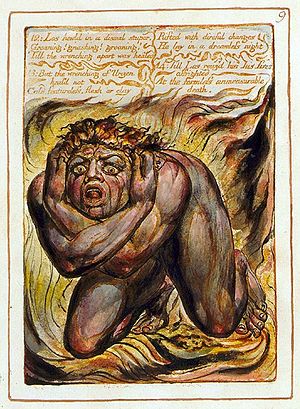Job.38
[1] Then the LORD answered Job out of the whirlwind, and said,
[2] Who is this that darkeneth counsel by words without knowledge?
[3] Gird up now thy loins like a man; for I will demand of thee, and answer thou me.
[4] Where wast thou when I laid the foundations of the earth? declare, if thou hast understanding.
[5] Who hath laid the measures thereof, if thou knowest? or who hath stretched the line upon it?
[6] Whereupon are the foundations thereof fastened? or who laid the corner stone thereof;
[7] When the morning stars sang together, and all the sons of God shouted for joy?
[8] Or who shut up the sea with doors, when it brake forth, as if it had issued out of the womb?
Job Confessing his Presumption to God who Answers from the Whirlwind, 1803-1805, National Gallery of Scotland, Edinburgh.
 Job.42
Job.42[1] Then Job answered the LORD, and said,
[2] I know that thou canst do every thing, and that no thought can be withholden from thee.
[3] Who is he that hideth counsel without knowledge? therefore have I uttered that I understood not; things too wonderful for me, which I knew not.
[4] Hear, I beseech thee, and I will speak: I will demand of thee, and declare thou unto me.
[5] I have heard of thee by the hearing of the ear: but now mine eye seeth thee.
[6] Wherefore I abhor myself, and repent in dust and ashes.
Thomas Butts followed up his commission for the biblical series with a request for a series of watercolors on the Book of Job. (1805-06) This set of images was copied by Blake 15 years later for John Linnell (1821). From the paintings a set of engravings, Illustrations to the Book of Job, was conceived by John Linnell as well. Blake began work on them in 1823 and they were printed by a conventional printer in the quantity of 150 sets in 1726. They represented the final project completed by Blake before his death in the next year.
Martin Butlin in the Tate publication William Blake, (page 98) states:
"In the last stage of the evolution of the designs, in some cases literally as they were being engraved, Blake added marginal designs with their texts which stress and add further subtleties to his own personal interpretation. The prints show Blake's engraving techniques at their height with a technical subtlety that that matches the richer and more sophisticated finish of his late paintings in tempera and watercolor."
Milton Klonsky in William Blake: The Seer and His Visions (page 131) writes:
"The quotations from Job and the outline engravings in the margins were added by Blake only after the illustrations themselves were completed. 'This decision,' declares Ruthven Todd, 'turned the series from just an important part of his life's work into a creation of almost unique grandeur.'"
The culmination of Blake's long association with the Book of Job, as he responded to the message of Job and interpreted it in visual images, was fitly climaxed by the publication of these 22 images.

















